Central and Northern Thailand Birding Tour
 22nd January-12th February 2026: Thailand birding tour highlights include Spoon-billed Sandpiper, Siberian Rubythroat, Great Hornbill, Giant Nuthatch, Blue Pitta, Siamese Fireback, Black-and-red Broadbill, Mrs Hume’s Pheasant, Yellow-breasted Bunting, Long-tailed Broadbill, Pied Harrier, Scarlet-faced Liocichla, Asian Dowitcher, Dark-sided Thrush, Silver-eared Mesia, Nordmann’s Greenshank, Chinese Egret – £4695 Per Person
22nd January-12th February 2026: Thailand birding tour highlights include Spoon-billed Sandpiper, Siberian Rubythroat, Great Hornbill, Giant Nuthatch, Blue Pitta, Siamese Fireback, Black-and-red Broadbill, Mrs Hume’s Pheasant, Yellow-breasted Bunting, Long-tailed Broadbill, Pied Harrier, Scarlet-faced Liocichla, Asian Dowitcher, Dark-sided Thrush, Silver-eared Mesia, Nordmann’s Greenshank, Chinese Egret – £4695 Per Person
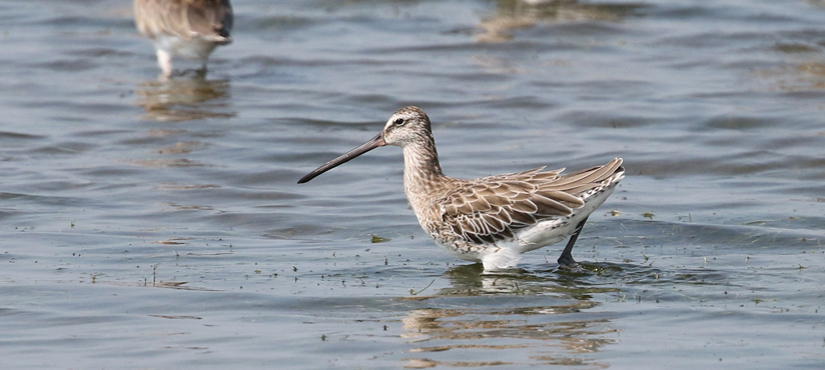
Trip Details
- Dates: 22 Jan-12 Feb 2026
- Cost: £4695
- Single Supplement: £700
- Deposit: £700
- Tour length: 22 Days (20 days birding)
- Min/Max group size: 5 / 9
- Start/Finish: Chiang Mai/Bangkok
- Tour Type: Birding
- Photo Opps: Very good
- Physical Classification: Easy
- Leaders: Joma Blair & Udorn Sanders
If you have any questions about this trip please feel free to ask by contacting us at info@calidrisbirdingtours.com
Thailand Birding; Central & Northern Regions
Picture yourself immersed in a country full of new cultural, culinary and architectural experiences coupled with a variety of habitats as diverse as coastal wetlands, lowland tropical forest, dry dipterocarp woodland, lotus swamps, evergreen montane forest and rice fields; more importantly, a country where exciting species including Spoon-billed Sandpiper, Great Hornbill, Blue Pitta, Banded Broadbill and Siberian Rubythroat can all be seen. That is birding in Thailand.
Thailand is at the heart of Southeast Asia and the meeting point of three biogeographic zones blessing the kingdom with a large and varied avifauna that includes lots of colourful, tropical species alongside many much-desired East Asian migrants. The welcoming people, the well-developed infrastructure, comfortable accommodation and delicious food along with an amazing array and number of birds make Thailand the ideal country for birding in, especially for those making a first trip to the region. Thailand is a safe and enjoyable country to travel in as well as an awesome birding destination. The habitats and birds of the northern region have a strong affinity to the Himalayas although east Asian migrants give a hint of the cultural trends of the region. The mountain peaks of the north often provide pleasantly cool temperatures to go birding in with comparison to the hot lowlands but both have ornithological delights in store of equal excitement. In the central region tropical forests with amazing strangler fig trees extend from the borders with Myanmar and Cambodia into Thailand while closer to the coast mudflats, salt farms and rice fields provide an interesting contrast as well as an insight into some traditional Thai ways of life.
With such variety of habitats and biogeographical regions there comes a huge number of species. In terms of species diversity, numbers and rarity value the Gulf of Thailand is the best wader-watching site in the world and it is here that we expect to find the iconic and critically endangered Spoon-billed Sandpiper while the tropical forests hold such gems as Great Hornbill and Blue Pitta. Colourful birds in the northern forests include Green-tailed Sunbird, Ultramarine Flycatcher and Yellow-cheeked Tit although we will not ignore skulking “little brown jobs” such as Pygmy Cupwing or Aberrant Bush Warbler. Throw in a huge supporting cast of shorebirds, woodpeckers, bulbuls, leaf warblers and raptors and you have some of the best birding in the world.
Day1, Arrival in Thailand – 22nd January 2026
Overnight flights arrive in Bangkok on the morning or early afternoon of 22nd January with a short domestic flight to Chiang Mai to follow. A short taxi ride will take you to our hotel at Chiang Mai airport for check in and at dinner there will meet your guides and have a pre-tour briefing.
Day 2, Mae Taeng Irrigation Area – Doi Lang West – 23rd January 2026

Leaving in the early morning a drive of around an hour will get us to Mae Taeng, shortly after sunrise, to make the most of the early morning bird activity. We will have breakfast in the field while, hopefully, enjoying a flock of graceful Small Pratincoles; a species that is cute when on the ground and striking when in flight. We will spend a few hours at this little site which serves as an excellent introduction to birding in Thailand. Here an abundance of common species such as Black-collared Starling, White Wagtail, Dusky Warbler, Chestnut-tailed Starling, Common Iora, Baya Weaver, Chinese Pond Heron, Sooty-headed Bulbul, Red-whiskered Bulbul and many more coming in thick and fast will serve as a sort of birding second breakfast. There is also the chance of something rarer too here such as Long-billed Plover or Black-faced Bunting.
It is not just common species here though, this spot is also a great place for turning up a couple of cryptic and skulking species that can be hard to find on a Thailand birding tour, even though they are not exactly rare. Chestnut-capped Babbler and Eurasian Wryneck are two notable species that we can usually find here as well as Thick-billed Warbler, Yellow-bellied Prinia and even the stunning Siberian Rubythroat .
The muddy edges of the river here usually attract a few of the commoner shorebirds such as Green Sandpiper, Little Ringed Plover and Black-winged Stilt but occasionally something less common shows up such as Temminck’s Stint or Greater Painted Snipe. One species that is fairly scarce in Thailand but can usually be seen at Mae Taeng is the crisply-plumaged Wire-tailed Swallow but mostly we intend to familiarize ourselves with birds such as Amur Stonechat, Plain Prinia, Greater Coucal and Asian Green Bee-eater while hoping that something less common, like Lesser Coucal, shows up too.
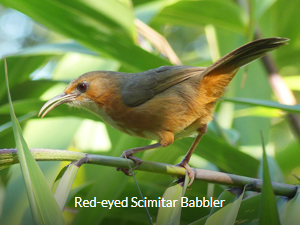
By mid-morning we will leave and drive a few hours north to the small town of Fang for a lunch stop. After this we head uphill to Doi San Ju (Doi Lang West) where we can expect some close-up views of some exciting birds. A series of stakeouts usually provides us with a wonderful afternoon with species including Silver-eared Laughingthrush, White-gorgetted Flycatcher, Red-eyed Scimitar Babbler, Slaty-blue Flycatcher, Spot-breasted Parrotbill and Rufous-gorgetted Flycatcher.
Our visit will also be timed to see some nice birds that feed in flocks in one of the shady areas of forest that usually has good levels of bird activity in the afternoon with Himalayan Cutia at the top of our list of desired species. Groups of Yunnan Fulvettas are often joined by Golden Babbler and Marten’s Warbler while Hume’s Treecreeper and Golden-throated Barbet can also frequently be seen in the area.
In the late afternoon it is here that we have our first chance of seeing Mrs Hume’s Pheasant before heading down to our accommodation around one hour away in the town of Fang.
Day 3, Doi Ang Kang – 24th January 2026
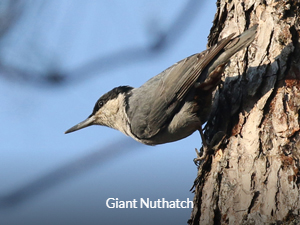
Visiting Doi Ang Kang will see us at the right spot as the sun hits a patch of pine forest. At this point birds are very active in the early morning with Giant Nuthatch frequently performing extremely well along with Chestnut-vented Nuthatch, White-browed Shrike Babbler, Asian Tit, Long-tailed Minivet and many others. The attractive Striated Bulbul often comes to feed in fruiting trees in this area along with Golden-throated Barbet, Crested Finchbill and Mountain Bulbul. The tops of the open pines are a good place to spot the colourful Maroon Oriole and there will surely be plenty of Hume’s Warblers here as well as a few singing Davison’s Leaf Warblers. There are a lot of possibilities at this time of day.
The jagged peaks of Doi Ang Kang contain a variety of wooded, farmed and grassy habitats and overall this is the most scenic area we visit on this Thailand birding tour with plenty of opportunity throughout the day to take in the views across the mountains and into Myanmar. Of course there will be plenty of birds too, checking out flowering trees in the Royal Project can turn up the stunning Mrs Gould’s Sunbird, Spot-winged Grosbeak, noisy Orange-bellied Leafbird, Streaked Spiderhunter, Blue-throated Barbet and Slender-billed Oriole among others. This is also a good location to check for Black-breasted Thrush foraging in leaf litter.
A nearby temple is always worth a visit where birds get fed every day creating a hotspot that usually attracts gangs of superb Silver-eared Mesias, a bird that is full of visual impact. Black-breasted and perhaps Eyebrowed Thrushes are likely to feed here too along with Red-whiskered Bulbuls, Olive-backed Pipits and perhaps a surprise or two. This is also a good spot to look for Large Niltava, a bird that usually gives itself away with its easily recognizable song. Birding in a variety of orchards, gardens and villages through the day always reveals a wide variety of species including Brown-breasted Bulbul, Crested Finchbill, Burmese Shrike, Great Barbet, Stripe-breasted Woodpecker, Scarlet Minivet and Black Bulbul. Hopefully there will also be some of the rarer species to search for that can include Black-headed Greenfinch and Daurian Redstart.
Day 4, Doi Lang West – Fang Rice Fields – 25th January 2026
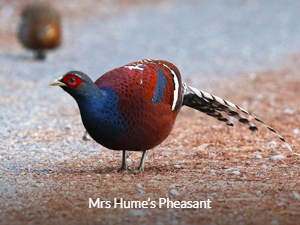
Today it will very important to be in exactly the right spot early enough to set up and wait for the emergence of one of the key target species of northern Thailand: Mrs Hume’s Pheasant. At this time of the year several of these rare birds come out to feed in the open just as the sun hits the right spot so we aim to be there before time so as not to disturb them. We are hoping to be able to watch this beautiful species at length and other species that might join them include Red-eyed Scimitar Babbler and even some arboreal birds such as Chestnut-vented Nuthatch, Olive-backed Pipit, Asian Tit and Ultramarine Flycatcher. This should be a really great start to the day.
On this side of the mountain the habitat is one of mixed open forest, pine trees, an understorey of grasses with patches of moister forest; this variety means there are a lot of different birds to see. In the grassy area Buff-throated Warbler and Rufescent Prinia are fairly easily seen but Aberrant Bush Warbler and Grey-crowned Warbler are faster-moving and more skulking – tricky! In the ancient pines we expect to find Giant Nuthatch, often calling from exposed perches, and birds such as White-browed Shrike Babbler, Long-tailed Minivet, Slender-billed Oriole and Grey-capped Pygmy Woodpecker are likely to join them.
Moving on we can check the stakeouts again to see if there are any birds we did not see before. Often White-bellied Redstart, Hill Prinia or something rarer take a bit more waiting than we may have done on our previous visit. Flocks of birds usually contain Dark-backed Sibia, Yunnan Fulvetta, Blue-winged Minla and Claudia’s Leaf Warbler but the flocks containing species such as Rufous-backed Sibia and Giant Nuthatch will be worth a closer look. These species tend to indicate the presence of scarcer birds such as Himalayan Cutia which is rare and often inconspicuous, while groups of Grey-headed Parrotbill may also share the same food source. We would do well to see all of these in one visit, but that is why we make multiple excursions up the mountain, to give ourselves the best chance of seeing as many of these superb birds as possible without being in a rush to tick them all off in a short space of time and inevitably miss many of them.
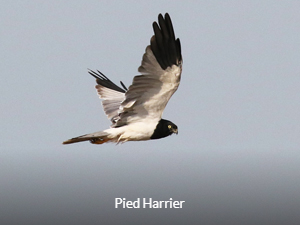
In the late afternoon we plan to descend from the mountain and check out a small area of rice fields for a few key species as the sun begins to get low in the sky. Common species such as White Wagtail, Black-collared Starling, Amur Stonechat and Chinese Pond Heron are well-represented here but it is also a good spot to enjoy the song flight of Oriental Skylark and by standing and waiting we should get good views of this species. Rice stubble in this area contains a few Chestnut-eared Buntings and Bluethroats. Both of these can be hard to observe well but with aptience and by staying late there is a good chance of getting views of both of these species perched on top of some vegetation.
Checking out a pool of water usually reveals Black-winged Stilt and Common Moorhen and there are sometimes a few ducks too; Garganey being the most likel species. As the sun begins to set we will keep out eyes open for Pied Harrier quartering over the fields and if we spot an adult male it will be a great end to the day. We will be out to dusk but our accommodation is very nearby.
Day 5, Doi Lang East/Doi Ang Kang – Thatorn Rice Fields – 26th January 2026
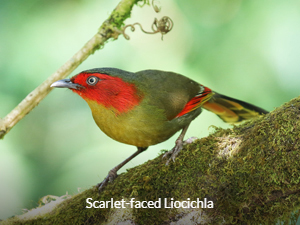
Breakfast at our guesthouse is followed by a short drive uphill and then a change of vehicle. Suitable local transport will take us up the rutted road that ascends Doi Lang East where some superb birds await us. Stopping at a lookout allows us to spot species that include Mountain Imperial Pigeon, Black Bulbul, Blue-throated Barbet, Maroon Oriole, Slender-billed Oriole and Stripe-breasted Woodpecker as they go about their morning business. This can be a good place to see Cook’s Swift at close range too and there is often a surprise or two; perhaps some Long-tailed Broadbills, a Bamboo Woodpecker or flypast Grey-headed Parakeets?
However, it is further up the mountain, in an area of moist forest at an altitude of around 2000 metres that the real reason for coming here is revealed. At a border police checkpoint there is a regular spot for getting incredible views of Scarlet-faced Liocichla, one of the most colourful and stunning birds of this Thailand birding tour. Joining them are likely to be Silver-eared Laughingthrush, Dark-backed Sibia and wonderful Spectacled Barwings.
Just hanging around and taking this area in usually provides lots of other good birds including close-up studies of Buff-barred Leaf Warbler and Davison’s Leaf Warbler, allowing you to get to grips with two of this challenging group of birds. Whiskered Yuhina often comes to feed on low branches here and Chestnut-crowned Warbler, Orange-bellied Leafbird, Mountain Bulbul, Mrs Gould’s Sunbird and Ashy Bulbul will often join them. In some years, if the weather has been cold in northern regions, a thrush or two will make a winter territory here with the most likely candidates being Eyebrowed Thrush and Chestnut Thrush.
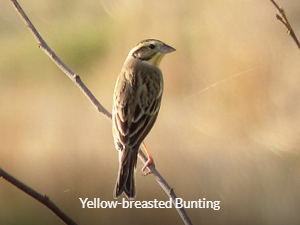
Lots of other species can be found in this area too so we should not have to go too far to find Large Niltava, Himalayan Bluetail or White-tailed Robin and with a little luck we might spot a soaring Mountain Hawk Eagle. We will have a picnic lunch while we wait to see what else arrives and look for mixed flocks of birds roving through the area. We can also check to see if any active stakeouts are attracting skulking birds that can include Chestnut-headed Tesia, Pygmy Cupwing and White-gorgetted Flycatcher.
As the day cools down we will drive a very short distance to nearby Thatorn rice fields where we should add birds such as Citrine Wagtail, Pied Bushchat, Grey-headed Lapwing, Plain Prinia and Yellow-bellied Prinia to our list. However, it is the critically endangered Yellow-breasted Bunting that we are really here to see and a small flock of up to a hundred birds regularly comes in to patches of riverside vegetation before roosting. This is a really great bird to end a memorable day with.
Day 6, Doi Lang West – 27th January 2026
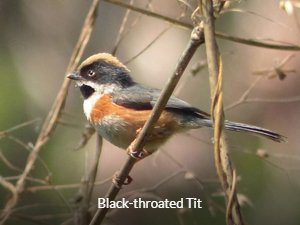
Another visit to Doi Lang West (Doi San Ju) gives us another chance to ensure we see Mrs Hume’s Pheasant or any other key species not yet seen. Hopefully we should have already enjoyed the pheasant to the full so this morning could be devoted to a different spot on the same mountain. Perhaps rare species such as Necklaced Woodpecker might be known to be active in one of its semi-regular places or perhaps even the extremely rare, although annual, Scarlet Finch. We might still be looking for a flock of cute Black-throated Tits. It is likely that skulking Aberrant Bush Warbler will still be eluding us and it often takes some effort to track down Himalayan Cutia.
The possibilities on Doi Lang are many and this visit gives us the chance to find some of the rarer birds, get improved views of some we have seen before and to become more familiar with some of those seen just once, briefly before.
The shady areas of forest are usually the best areas for birding by mid-morning as things get warmer and by tracking down flocks of small birds we should be able to find White-spectacled Warbler; this is the only known location for this species in Thailand! Larger birds that can forms flocks are another target here and it can take several visits to locate them; Grey-headed Parrotbill will sometimes join flocks that contain Rufous-backed Sibia and Himalayan Cutia. These are all superb birds and one of the main reasons for making mulitple visits to this location in order to maximise success.
After a picnic lunch we are likely to head down the mountain to take a break in the hotel before heading out again in the mid-afternoon for the river at Thatorn where we expect to get close views and photographic opportunities of Small Pratincoles both settled and flying up and down the river. This is a good spot for species such as Long-tailed Shrike, Pacific Golden Plover, Green Sandpiper, Little Ringed Plover and Pied Bushchat. Hirundines frequently descend to feed over the river in the late afternoon and can include Eastern Red-rumped Swallow and Wire-tailed Swallow. Sometimes we find Siberian House Martin here.
Day 7, Fang Hot Springs – Doi Inthanon – 28th January 2026

After a long day on the previous day we do not need to get up particularly early to get to Fang Hot Springs at the right time. A fifteen minute drive after breakfast gets us there at a great time to spot Asian Barred Owlet, Coppersmith Barbet and the distinctive Eurasian (White-faced) Jay early on. Exposed perches are a magnet for birds in the early morning, as the sunshine first hits them, with Lineated Barbet, Great Barbet, flocks of Chestnut-tailed Starlings and a selection of the commoner bulbuls all taking advantage of this. Fast-moving flocks of minivets are regular too with Long-tailed Minivet being common sometimes with a few Rosy Minivets in attandance.
The main reason to visit, though, is to view a regular flock of Spot-winged Grosbeaks that favour a few trees in particular. We only intend to spend a short morning here but it is also a great place to see Blue Rockthrush at close quarters as well as Two-barred Warbler and Eastern Red-rumped Swallow at eye-level. As the morning warms up treetops are a good place to look for birds such as Green-billed Malkoha, Shikra or even Blue-throated Bee-eater and there are often one or two surprises here – perhaps Pin-tailed Green Pigeon or Little Cuckoo Dove feeding on a fruiting tree.
By mid-morning, after a coffee, we will start our journey south towards our next destination, Doi Inthanon. Including a lunch stop along the way this journey will take us about five hours and we will have time to settle in and relax a little before dinner.
Days 8-10, Doi Inthanon – 29-31st January 2026
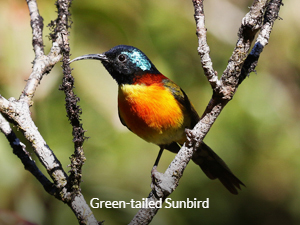
We have three full days to enjoy the birds of Doi Inthanon. This is Thailand’s tallest mountain and as such it contains a wide range of altitudinal habitats. In this variety of habitats are wide range of species for us to see. At the summit are some really special birds with colourful Green-tailed Sunbirds, Chestnut-tailed Minlas, Rufous-winged Fulvettas and Mrs Gould’s Sunbirds. Another summit speciality is Ashy-throated Warbler, a Phylloscopus that everyone should be able to identify without a problem! Silver-eared Laughingthrush abounds up here and fruiting trees can attract Grey-sided Thrush, Yellow-bellied Flowerpecker and Golden-throated Barbet. If we time it right we should see both Ashy and Speckled Woodpigeons while on the summit boardwalk we will look for skulking Dark-sided Thrush, White-browed Shortwing and Pygmy Cupwing.
Slightly lower down the mountain birding will be along a quiet track where flocks of birds usually contain Yellow-cheeked Tit, Clicking Shrike Babbler, Grey-chinned Minivet, Silver-eared Mesia, Mountain Tailorbird, Rufous-backed Sibia and many other species.
This is also a good place to look for Slaty-bellied Tesia, a tiny bird that behaves like a clockwork toy, and Hume’s Treecreeper. In this area Green Cochoa sometimes appears but we will need a fair bit of luck to see this bird although Large Niltava, Marten’s Warbler and Little Pied Flycatcher should be easier. Other birds to look for here include Asian Emerald Cuckoo, Grey-throated Babbler and White-browed Scimitar Babbler.

Streams and waterfalls at Doi Inthanon contain some nice birds and we have a good chance to find Slaty-backed, White-crowned and Black-backed Forktails, such elegant birds, although extremely shy so we will need to be quiet and move slowly. White-capped Water Redstart is a lovely bird too and we should see this at one of the waterfalls along with Plumbeous Redstart.
There will be time to visit a hide too where we can expect some extremely close views of a number of regularly attending species; an excellent opportunity for photos! Cute little Buff-breasted Babblers join Brown-cheeked Fulvettas and Grey-throated Babblers in gobbling up fod from the forest floor while both Little and Streaked Spiderhunters show up to drink. White-tailed Robin and Siberian Blue Robin often enter from the undergrowth to feed and to drink and fruit attracts Puff-throated Bulbul and Grey-eyed Bulbul. The brightest splash of colour here is usually supplied by Rufous-bellied Niltava and sometimes Orange-bellied Leafbird will visit too. If our luck is in then there are a few other possiilities.
We also plan to make a brief visit to the dry dipterocarp woodland at the base of the mountain. Birds here are few and far between but we know where there is a roost site of Collared Falconet and if we hang around until very late Black-headed Woodpeckers should show up too. Doi Inthanon has a lot of possibilities for us.
Day 11, Doi Inthanon – Bangkok – 1st February 2026
We will use the early morning to visit a viewing tower that is close to our accommodation. This tower looks over an area of regenerating dry dipterocarp woodland and gardens with flowering trees in them which attract a nice range of birds that can be seen at close quarters such as Black-hooded Oriole, Hair-crested Drongo, Purple Sunbird, Coppersmith Barbet, Brown-throated Sunbird and many others. However, there are two species that are our prime targets here; Blossom-headed Parakeet and Green Peafowl. The parakeets usually perch on exposed trees at some point during our visit and the Green Peafowl sit out on the treetops at first light and then come to feed on supplementary food a little later on. By mid-morning we will travel towards Chiang Mai airport, have lunch and catch an early afternoon flight to Bangkok.
We arrive by mid-afternoon and take a short walk to our hotel for the night where we have a few hours to relax, catch up with emails, process photographs and recharge the batteries before starting the central Thailand section of our birding tour.
Day 12, Khok Kham – Kaeng Krachan – 2nd February 2026

For many this will be the most anticipated morning of this Central and Northern Thailand Birding Tour. Leaving Bangkok in the early morning we will arrive at Khok Kham very shortly after first light for a field breakfast and where we expect to locate one or two of the few critically endangered Spoon-billed Sandpipers that winter here. Over the last few years this has become the easiest location to find this exciting species and we will concentrate on getting satisfying views of Spoon-billed Sandpiper.
Here there are likely to be good numbers of the impressive Painted Stork too and as the sun rises there will be a flypast of Little and Indian Cormorants, small numbers of Brown-headed Gulls along with Whiskered Terns. While looking for Spoon-billed Sandpiper there will be plenty of other shorebirds including large flocks of Tibetan Sand Plover along with the very similar Greater Sand Plover. Groups of feeding Red-necked Stints will feature as we check them for our much rarer target species and Broad-billed Sandpiper as well as Curlew Sandpiper will be among them too. Here we will see a wide range of the commoner shorebirds but will take more time to enjoy them a little later in the trip when we visit Pak Thale and Laem Pak Bia; this morning is really all about Spoon-billed Sandpiper.
By mid to late morning we will start our journey to our accommodation at Kaeng Krachan, having lunch there before the afternoon’s plan.
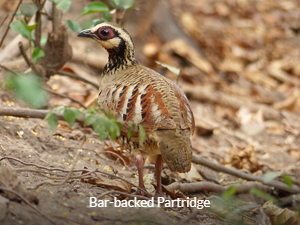
In the afternoon the plan is to sit in a hide that overlooks a bathing and feeding area in a patch of dry forest. Here many species of birds come to take advantage of the water and food giving us incredibly good views of them. This is a great way to get point-blank sightings of some of the common forest birds that can be tricky to see well. Species like Black-naped Monarch, Puff-throated Babbler, Indochinese Blue Flycatcher and Siberian Blue Robin are usually easily seen here. Lesser Necklaced Laughingthrush and Greater Necklaced Laughingthrush regularly appear too and when they arrive in a gang they make quite a commotion only eclipsed by White-crested Laughingthrush. We hope for some really shy birds to arrive here, so if we are very quiet. Large Scimitar Babbler, Bar-backed Partridge, Grey Peacock Pheasant, Kalij Pheasant and Green-legged Partridge could all appear but for sheer colour Ferruginous Partridge is hard to beat. If things have been very dry the show here can be quite spectacular with Common Green Magpie, White-browed Scimitar Babbler and even Greater Yellownaper all possible. Visiting this spot usually provides a lot of lasting memories, none more endearing than the cute little Lesser Mouse Deer.
Days 13-15, Kaeng Krachan National Park – 3-5th February 2026
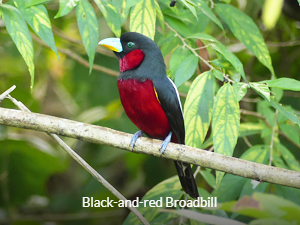
Three full days at this fantastic location give us the time we need to focus on the key species here. We will split our time between the lowlands and upper levels, both of which have a distinctive set of birds to look for. This national park is the largest in Thailand and is just a part of a large area of forest along the Thai-Myanmar border which is home to a healthy population of a wide variety of wildlife including mammals such as Leopard, Tiger, Gaur and Asiatic Elephant. Seeing these would require a lot of luck but the bird communities here are just as rich.
In the lower altitudes we are hoping to see several species of broadbills including the elegant Silver-breasted Broadbill which usually starts to become detectable at this time of year. As well as this beauty we have a high probability of finding some really crazy looking birds in Black-and-red Broadbill, Black-and-yellow Broadbill and Banded Broadbill. These are just the sort of colourful, tropical birds we travel the world to see. Here we have another chance at Blue Pitta if we did not already see it at Khao Yai as well as Great Hornbill, Banded Kingfisher and several other species.
Orange-breasted Trogon and Sultan Tit are two amazing birds which are usually found at Kaeng Krachan while in the early morning Green-eared Barbet, Greater Flameback, Asian Fairy Bluebird, Greater Yellownape and Oriental Dollarbird often perch out in the open. Fruiting trees can attract Tickell’s Brown Hornbill as well as numerous Oriental Pied Hornbills as well as Common Hill Myna, Eyebrowed Thrush, Blue-eared Barbet and many other species. Kaeng Krachan is a good place for woodpeckers and we hope to find several species from the little Heart-spotted Woodpecker to the monster Great Slaty Woodpecker. Other species here include Black-thighed Falconet, Blue-bearded Bee-eater, Golden-crested Myna and Boobook, demonstrating what an excellent birding site this is.
The higher altitudes of Kaeng Krachan contain more superb birds. The incredible Ratchet-tailed Treepie is the key species here; its tail looks like some sort of medieval war weapon! This species often follows flocks of other birds that include smart Collared Babblers, White-browed Scimitar Babblers and Black-throated Laughingthrushes. While the treepie will be our main focus there are a lot of birds up here and it gives us a chance to get better views of some species from the north. Perhaps Blue-throated Barbet, Great Barbet, Mountain Imperial Pigeon or Speckled Piculet will show themselves well. This part of the national park also gives us the possibility of a few birds that we will not have encountered elsewhere due to range restrictions. Cute little Rufous-browed Flycatcher inhabits the undergrowth and Grey Peacock Pheasant may cross the road if we are lucky. Red-bearded Bee-eater is always possible in this area too, quite an amazing creature.
Day 16, Kaeng Krachan National Park- Petchaburi Rice Fields – 6th February 2026
We will use our final morning at Kaeng Krachan to looking for any species we have not already seen. This may mean a visit to another nearby hide if we know of any special species that are regularly visiting. Between here and the afternoon’s birding we will make a short stop at a reliable stakeout for Indian Thick-knee, lounging around under bushes in the heat of the day.
We continue the journey arriving at Petchaburi rice fields in time to see Asian Golden Weavers starting to come into breeding plumage and building their nests in vegetation emerging from the watery ditches. Alongside them we also expect large numbers of Baya Weavers as well as smaller numbers of Streaked Weaver. Rice fields here are often full of large numbers of Asian Openbill as well as Little, Great and Intermediate Egrets with overgrown edges harbouring Bronze-winged Jacana and Ruddy-breasted Crake. We will make an effort to locate areas of habitat that have the right combination of low water levels and floating vegetation which attract Pheasant-tailed Jacana, Cotton Pygmy Goose and White-browed Crake.

Skulking species such as Black-browed Reed Warbler, Oriental Reed Warbler and Chestnut-capped Babbler occur in roadside reeds and Typha giving us another chance of them if not previously seen. Pallas’s Grasshopper Warbler often occurs in this area while species such as Plain Prinia and Yellow-bellied Prinia are fairly common. Staying out until the late afternoon is usually rewarding as birds emerge from their shady hiding places. Pink-necked Green Pigeons gather on roadside wires, Oriental Darters fly overhead and Stork-billed Kingfisher may emerge too. This location usually provides us with lots of interesting birds and is a nice change of pace to break up forest birding on this trip.
Other possibilities here include Yellow Bittern, Chestnut Munia, Freckle-breasted Woodpecker, Cinnamon Bittern, Brahminy Kite, Grey-headed Lapwing and Watercock. As the day draws to a close there can be a real flurry of bird activity here and it is only a short drive to our hotel for a well-earned shower, dinner and a beer.
Day 17, Pak Thale/Laem Pak Bia – 7th February 2026
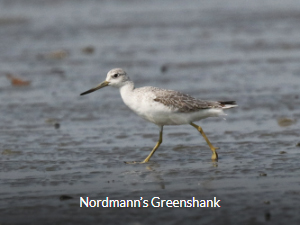
We expect to have enjoyed great views of Spoon-billed Sandpiper already but this morning gives us another chance of seeing this special bird. Sometimes we find this species within moments of arrival, other times it can take up to a few hours of searching, but this bird is very reliable here. Commoner species here include Curlew Sandpiper, Broad-billed Sandpiper, Kentish Plover, Tibetan Sand Plover, Red-necked Stint, Marsh Sandpiper, Black-tailed Godwit and Spotted Redshank. Groups of terns are likely to include the huge Caspian Tern as well as tiny Little Terns and Brown-headed Gull is common and we may be able to spot a Slender-billed Gull among them.
If we have already seen Spoon-billed Sandpiper well we will focus on finding Nordmann’s Greenshank and Asian Dowitcher, both key target species. While the greenshank has a fairly reliable area it favours, the dowitcher will require searching the vast area of salt farms and fish ponds that cover this region. Along the way, as we search, we are likely to add lots more species to our list such as Ruddy Turnstone, White-winged Tern, Common Greenshank, Pied Avocet, Grey Plover and several others.

Pre-historic-looking Painted Storks will also be a feature, wading around in the deeper water, while other shorebirds should include Terek Sandpiper, large flocks of Great Knot, Long-toed Stint, Greater Sand Plover, Temminck’s Stint, Ruff and Bar-tailed Godwit.
Some birds prefer the sand spit that the district of Laem Pak Bia is named after and today includes a pleasant boat trip to take us out there, looking out for Collared and Black-capped Kingfishers along the way. On arrival we bird on the beach where we expect to find handsome Malaysian Plover which breeds here in small numbers. This is where we should find White-faced Plover too and at this time of the year the males should be coming into their very distinctive breeding plumage. Chinese Egret is also another key bird in this area, usually feeding on exposed mud. We also expect Pacific Reef Egret, Great Crested Tern and Sanderling and sometimes the large flock of terns here can include small numbers of Lesser Crested Tern.
At dusk we can visit the nearby Royal Project where we can find Indian Nightjar and watch thousands of Lyle’s Flying Foxes emerge from the mangroves.
Day 18, Pak Thale/Laem Pak Bia/Petchaburi Rice Fields- Khao Yai – 8th February 2026
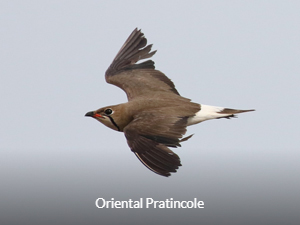
This area is one that is full of birds and so that we are not in a rush we have scheduled another morning here. This will allow us to enjoy the birds we see at a sensible pace as well as ensure that there is a second chance to find any of the key birds that we did not see on the first day. What we do exactly will very much depend on what we have seen previously. If there are any know rarities in the area, such as Black-faced Spoonbill or Milky Stork, we can target these. If we did not succeed in finding Asian Dowitcher then we can focus on this.
Alternatively we may visit another area of rice fields where in the early morning species such as Yellow-breasted Bunting, Red-throated Pipit, Siberian Rubythroat and Baikal Bush Warbler can often be seen. Dry areas here usually attract Oriental Pratincole by this time of the year and as the morning warms up this can be a real raptor hotspot with good numbers of both Brahminy and Black Kites with species such as Greater Spotted Eagle, Eastern Marsh Harrier,Pied Harrier and Booted Eagle being regular. Small numbers of Steppe Eagle and Imperial Eaglealso winter in this area.
A final stop at some fish ponds usually reveals Black-headed Ibis and the possibility of some Eurasian migratory ducks such as Northern Pintail, Garganey and Northern Shoveler as well as another chance to see species such as Black-capped Kingfisher, Golden-bellied Gerygone and Collared Kingfisher before we start the journey towards Khao Yai National Park, arriving in time to visit an area that is relaible for Red-breasted Parakeet.
Days 19-20, Khao Yai National Park – 9-10th February 2026
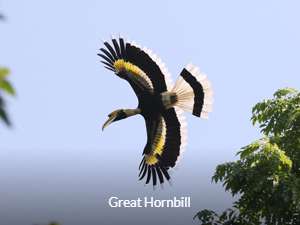
Two full days in Thailand’s oldest national park means that there is plenty of time to search for the key species that dwell within it. The quality of the forest here is exceptional with some of the most incredible strangler fig trees in Asia. Many of these trees have enormous canopies and have completely destroyed their original host tree creating an amazing structure. These fig trees can also be a magnet to wildlife and if we find a good fruiting fig species such as Great Hornbill, Thick-billed Green Pigeon, Asian Fairy Bluebird, Moustached Barbet, Oriental Pied Hornbill and White-handed Gibbon should all be present. Let’s hope we find one of these trees!
Birding at Khao Yai is not easy, we will require some patience and persistence for the best rewards here. Although there are a lot of superb birds that we hope to see many of them are very shy and difficult to find. However, we have allocated enough time here to have an excellent chance of finding many of them and top of our list of difficult targets is Blue Pitta. This is a real gem of a bird.
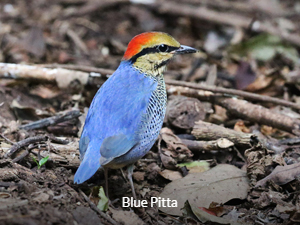
Blue Pitta is not rare but it is shy so we will need to be quiet and patient to get the best views. While we are in the realm of Blue Pitta we will also be on alert for the superb Red-headed Trogon, Banded Kingfisher, Long-tailed Broadbill as well as the wail of Coral-billed Ground Cuckoo. This bird is one of the most sought-after in Thailand and although, once again, it is not rare here, it is extremely hard to see. Some years it comes to a stakeout but usually a lot of luck is needed, although if it is calling we have a decent chance of luring it in.
Mammals are a feature at Khao Yai and there is a good chance of seeing wild Asiatic Elephants here, although if we do extreme care must be taken, these animals are dangerous. White-handed Gibbon, Red Muntjac, Sambar and Pig-tailed Macaque are all likely too and Black Giant Squirrel is an impressive beast. If we are extremely lucky we may see Malayan Porcupine, Dhole or even Asiatic Black Bear!
Birding along the road to the highest point of the national park is the best way to find Siamese Fireback and Silver Pheasant. Flocks of birds along here tend to include noisy White-crested Laughingthrush, Black-throated Laughingthrush, Common Green Magpie, Laced Woodpecker, Greater Racket-tailed Drongo and White-browed Scimitar Babbler. Flowering trees in campsites often draw in smaller birds such as Yellow-vented Flowerpecker, Cambodian Flowerpecker, Little Spiderhunter and Blue-eared Barbet. Areas of open country also provide us with the opportunity to watch beautiful Chestnut-headed Bee-eaters. We can also look out for raptors which usually include Crested Serpent Eagle, Crested Goshawk and Oriental Honey-buzzard but we might get lucky with Jerdon’s Baza or Rufous-bellied Eagle too.
Day 21, Khao Yai National Park- Bangkok – 11th February 2026
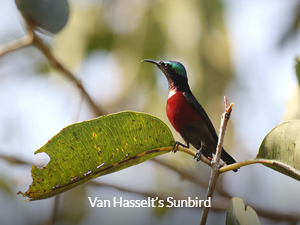
We plan to finish with a final morning of birding back in Khao Yai national park. This can be used to chase any of the difficult target birds that we have not yet seen; some of these birds require persistence. We will also use this time to visit a particular area of the forest for two little gems: Van Hasselt’s and Crimson Sunbirds.
Leaving after lunch we plan to make the journey to the hotel near Suvarnabhumi Airport before the traffic in Bangkok gets too bad.
The decision on exactly what to do on this final morning will be down to the guides after assessing how best to use the time and it may be that they decide to go somewhere completely different. We will try to maximise the chances of adding some more good birds to our list even at this late stage.
Returning to Bangkok we will have a final dinner together at our hotel.
Day 22, Departure – 12th February 2026
This Central and Northern Thailand birding tour will conclude with a transfer to Suvarnabhumi International Airport. Our hotel provides this service according to their shuttle bus timetable.
The list below contains many of the key species that we have a good chance of seeing based on the experience of previous visits. it is not an exhaustive list of target birds but they are all notable for the memories they create or for being range-restricted. Of course we cannot guarantee that we will see them all but we do expect to locate a high proportion of them. Forest birds can be hard to observe after all.
- Rufous-throated Partridge – Arborophila rufogularis
- Bar-backed Partridge – Arborophila brunneopectus
- Green-legged (Scaly-breasted) Partridge – Arborophila chloropsis
- Ferruginous Partridge – Caloperdix oculeus
- Green Peafowl – Pavo muticus
- Grey Peacock Pheasant – Argusianus argus
- Mrs Hume’s Pheasant – Syrmaticus humiae
- Kalij Pheasant – Lophura leucomelanos
- Silver Pheasant – Lophura nycthemera
- Siamese Fireback – Lophura diardi
- Speckled Woodpigeon – Columba hodgsonii
- Ashy Woodpigeon – Columba pulchricollis
- Pink-necked Green Pigeon – Treron vernans
- Great Eared Nightjar – Lyncornis macrotis
- Indian Nightjar – Caprimulgus asiaticus
- Brown-backed Needletail – Hirundapus giganteus
- Coral-billed Ground Cuckoo – Carpococcyx renauldi
- Painted Stork – Mycteria leucocephala
- Chinese Egret – Egretta eulophotes
- White-faced Plover – Charadrius dealbatus
- Malaysian Plover – Charadrius peronii
- Great Knot – Calidris tenuirostris
- Long-toed Stint – Calidris subminuta
- Spoon-billed Sandpiper – Calidris pygmaea
- Asian Dowitcher – Limnodromus semipalmatus
- Terek Sandpiper – Xenus cinereus
- Nordmann’s Greenshank – Tringa guttifer
- Small Pratincle – Glareola lactea
- Brown Boobook – Ninox scutulata
- Greater Spotted Eagle – Clanga lcanga
- Eastern Marsh Harrier – Circus spilonotus
- Pied Harrier – Circus melanoleucos
- Orange-breasted Trogon – Harpactes oreskios
- Red-headed Trogon – Harpactes erythrocephalus
- Great Hornbill – Buceros bicornis
- Austen’s Brown Hornbill – Anorrhinus austeni
- Tickell’s Brown Hornbill – Anorrhinus tickelli
- Oriental Pied Hornbill – Anthracoceros albirostris
- Wreathed Hornbill – Rhyticeros undulatus
- Red-bearded Bee-eater – Nyctyornis amictus
- Blue-bearded Bee-eater – Nyctyornis athertoni
- Banded Kingfisher – Lacedo pulchella
- Stork-billed Kingfisher – Pelargopsis capensis
- Moustached Barbet – Psilopogon incognitus
- Heart-spotted Woodpecker – Hemicircus canente
- Black-and-buff Woodpecker – Meiglyptes jugularis
- Black-headed Woodpecker – Picus erythropygius
- Great Slaty Woodpecker – Mulleripicus pulverulentus
- Collared Falconet – Microhierax caerulescens
- Blue Pitta – Hydrornis cyaneus
- Long-tailed Broadbill – Psarisomus dalhousiae
- Black-and-red Broadbill – Cymbirhynchus macrorhyynchos
- Silver-breasted Broadbill – Serilophus lunatus
- Banded Broadbill – Eurylaimus harterti
- Black-and-yellow Broadbill – Eurylaimus ochromalus
- Black-eared Shrike Babbler – Pteruthius melanotis
- Clicking Shrike Babbler – Pteruthius aenobarbus
- Burmese Shrike – Lanius colluriodes
- Ratchet-tailed Treepie – Temnurus temnurus
- Common Green Magpie – Cissa chinensis
- (White-faced) Eurasian Jay – Garrulus leucotis
- Sultan Tit – Melanochlora sultanea
- Indochinese Bushlark – Mirafra erythrocephala
- Black-browed Reed Warbler – Acrocephalus bistrigiceps
- Pygmy Cupwing – Pnoepyga pusilla
- Pallas’s Grasshopper Warbler – Locustella certhiola
- Crested Finchbill – Spizixos canifrons
- Brown-breasted Bulbul – Pycnonotus xanthorrhous
- Sulphur-breasted Warbler – Phylloscopus ricketti
- Slaty-bellied Tesia – Tesia olivea
- Black-throated Bushtit – Aegithalos concinnus
- Spot-breasted Parrotbill – Paradoxornis guttaticollis
- Grey-headed Parrotbill – Psittiparus gularis
- Whiskered Yuhina – Yuhina flavicollis
- Large Scimitar Babbler – Erythrogenys hypocleucos
- Red-eyed Scimitar Babbler – Erythrogenys imberbis
- Collared Babbler – Gampsorhynchus torquatus
- Himalayan Cutia – Cutia nipalensis
- Lesser Necklaced Laughingthrush – Garrulax monileger
- Black-throated Laughingthrush – Garrulax chinensis
- Greater Necklaced Laughingthrush – Pterorhinus pectoralis
- Silver-eared Laughingthrush – Trochalopteron melanostigma
- Silver-eared Mesia – Leiothrix argentauris
- Scarlet-faced Liocichla – Liocichla ripponi
- Bar-throated (Chestnut-tailed) Minla – Actinodura strigula
- Hume’s Treecreeper – Certhia manipurensis
- Giant Nuthatch – Sitta magna
- Dark-sided Thrush – Zoothera marginata
- Black-breasted Thrush – Turdus dissimilis
- Eyebrowed Thrush – Turdus obscurus
- Small Niltava – Niltava macgrigoriae
- Large Niltava – Niltava grandis
- Rufous-bellied Nilatava – Niltava sundara
- White-gorgetted Flycatcher – Anthipes monileger
- Himalayan Shortwing – Brachypteryx cruralis
- Siberian Blue Robin – Larvivora cyane
- Bluethroat – Cyanecula svecica (svecica)
- Siberian Rubythroat – Calliope calliope
- White-tailed Robin – Myiomela leucura
- Himalayan Bluetail – Tarsiger rufilatus
- Slaty-backed Forktail – Enicurus schistaceus
- Black-backed Forktail – Enicurus immaculatus
- White-crowned Forktail – Enicurus leschenaulti
- Rufous-gorgetted Flycatcher – Ficedula strophiata
- Ultramarine Flycatcher – Ficedula superciliaris
- White-capped Water Redstart – Phoenicurus leucocephalus
- Cambodian Flowerpecker – Dicaeum cambodianum
- Van Hasselt’s (Maroon-breasted) Flowerpecker – Leptocoma brasiliana
- (Doi Inthanon) Green-tailed Sunbird – Aethopyga nipalensis angkanensis
- Asian Golden Weaver – Ploceus hypoxanthus
- Spot-winged Grosbeak – Mycerobas melanozanthos
- Yellow-breasted Bunting – Emberiza aureola
The map below details the main birdwatching sites that we visit on this Thailand birding tour.
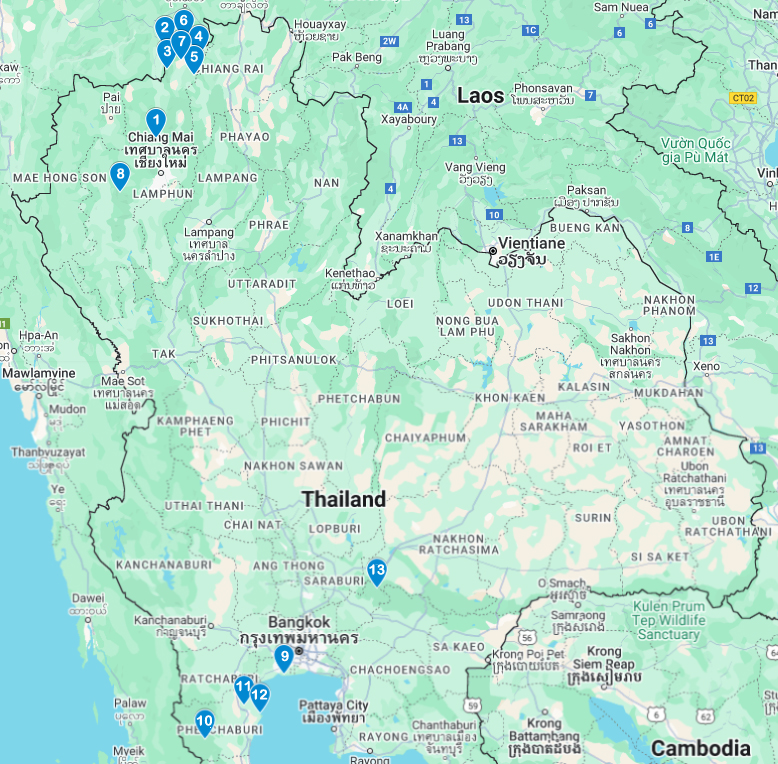
1. Mae Taeng
5. Fang Rice Fields
9. Khok Kham
13. Khao Yai National Park
2. Doi Lang West
6. Doi Lang East
10. Kaeng Krachan National Park
3. Doi Ang Kang
7. Fang Hot Springs
11. Petchaburi Rice Fields
4. Thatorn Rice Fields
8. Doi Inthanon
12. Pak Thale/Laem Pak Bia
The following is a selection of birds photographed in Thailand at sites that we will visit on this tour.
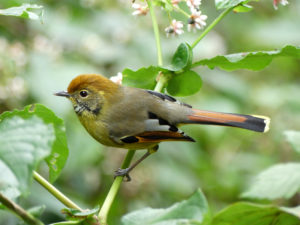
Bar-throated Minla 
Asian Openbill 
Lesser Necklaced Laughingthrush 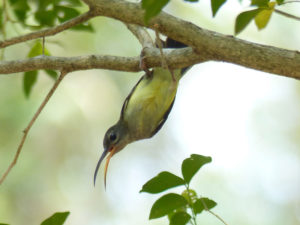
Little Spiderhunter 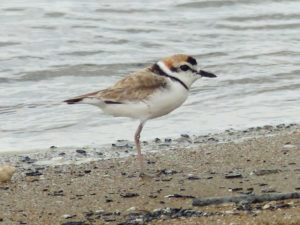
Malaysian Plover 
Crested Finchbill 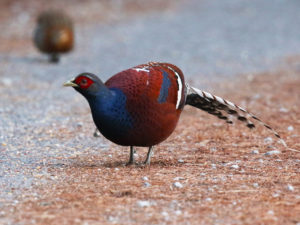
Mrs Hume’s Pheasant 
Orange-bellied Leafbird 
Great Knot 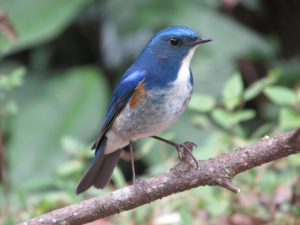
Himalayan Bluetail 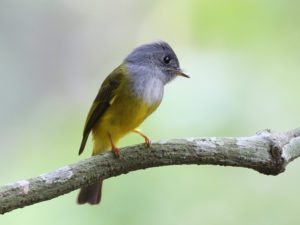
Grey-headed Canary-flycatcher 
Marsh Sandpiper
All above photographs copyright Nick Upton/Calidris Birding Tours.
Tour Details
Tour Cost: £4695 per person
Single Supplement: £700
Included in the tour cost: All transport including airport transfers, road tolls, national park entry fees, accommodation including on the night before commencement of the tour and on the final night, hide fees, all meals, bottled water, boat trip, services of English-speaking birding guide and Calidris Birding Tours guide.
Not included in the tour cost: International flights, travel insurance, visa (most nationalities get visa-free entry for up to 30 days), alcoholic and soft drinks, tips, laundry, excess baggage fees, hotel mini bar, phone calls and any other items of a personal nature. There have been rumours that camera fees may be introduced at some national parks; these fees will not be included in the tour cost should that happen.
Accommodation: All accommodation on this tour is good to very good in quality with all rooms having en-suite toilet and showers as well as air-conditioning. Hotels and guest houses are all the best balance of proximity to the birding sites with quality and convenience. Wifi is available at all locations although a little slow at one or two of them.
Physical effort: This is not a physically demanding trip with birding done along wide tracks and quiet roads with almost all walks being short distances. Long days in the field are normal though, but the carefully planned itinerary has ensures that there is not too much time pressure. This birding tour is suitable for most people.
Weather: Expect temperatures to be mostly high, Thailand is a tropical country. In the lowlands it will be hot for most of the day with maximum temperatures around 33C, perhaps higher at times. Humidity is high in all lowland areas. However, much of the tour in northern Thailand will occur at higher altitudes where in the mornings temperatures will be much cooler. At times in the early morning it could be quite chilly and a light fleece is useful. It is hard to predict how cool it will or will not be, each year is different.
Food: Thai food is famous as one of the world’s most popular cuisines. Although Thai food is famous for being spicy, most dishes can be adjusted to suit anyone’s taste so don’t let this put you off enjoying great food. Thai food is based on a variety of stir-fried dishes eaten with steamed rice. Most dishes are meat or fish based but catering to vegetarians is not a problem at all. Vegan food can also be provided although it may take a little more time in preparation. People with food allergies can also be catered for but please advise us in advance of any eating requirements you have so that we can check that we can provide for you.
Tour Leaders

Joma Blair
Joma’s love of birding was sparked witnessing throngs of bee-eaters, raptors and storks migrate over his childhood home in Egypt’s Sinai peninsula. Guided by his passion for the natural world ever since, he is soon to graduate with a Master’s at Imperial College London with a thesis on Antarctic seabird’s response to climate change. Alongside his studies he has birded on five continents, and this tour will be greatly enhanced by his deep scientific understanding of bird ecology and behaviour.
While every effort will be made to adhere to the advertised itinerary of this Central and North Thailand birding tour, we reserve the right to make changes in the case of unforeseen circumstances that are beyond our control. These include problems with accessibility, national park closures, unseasonal weather events or any other reason that may demand an itinerary change.
Recommended Field Guide
 Birds of Thailand
Birds of Thailand
In 2018 Lynx Edicions solved the problem of which field guide to recommend for birding tours to Thailand with this publication. This guide contains all of the species we are likely to see on this Thailand birding tour and deals with the question of varying taxonomies extremely well, making it relevant pre and post splitting for most species. We recommend that all participants on this tour obtain a copy of this field guide before the trip to become familiar with the bird families and many of the species to be seen.
The checklist that Calidris Birding Tours will issue for this trip will use IOC taxonomy with reference to the taxonomy used within this field guide.
Read our full review of the book here – Birds of Thailand.
Related Birding Blog Posts
- Parakeets & Peafowl – posted by Nick Upton 20/06/25
- Daap Toon hide at Kaeng Krachan NP – posted by Nick Upton 07/09/22
- An Afternoon at Nui Hide – posted by Nick Upton 21/01/20
- A Morning at Fang Hot Springs – posted by Nick Upton 16/04/19
- Doi Lang East Photography Day Trip – posted by Nick Upton 26/02/19
- A Big Wader Day – posted by Nick Upton 29/12/17
- Birding in Petchaburi Province – posted by Nick Upton 07/02/16
Terms and conditions: Please read the full Calidris Birding Tours terms and conditions which apply to the Central and Northern Thailand Birding Tour.


